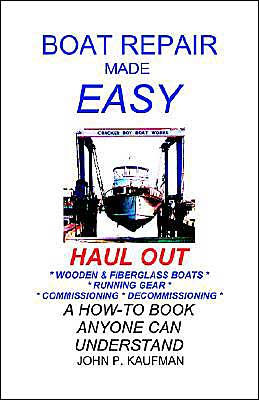Read an Excerpt
EXCERPT: From Chapter 1: The first question often to arise when discussing the hauling of a boat is; "How often should I haul my boat?" I wish there was a simplistic answer to this question, but there is not. The time frame between haul out depends on many circumstances. The two main concerns are your location in the country and the hull material of your boat.
Typically, if you are in an area of the country that requires you to do a winter lay-up and you own a boat with a hull material other than wood, the question is easily answered. Haul it for the winter. If you own a wooden boat in such an area, you still have the choice of in water lay-up (my preference) or land lay-up.
If you prefer to stay in the water for the winter, the wooden boat should be hauled as soon as the weather is warm enough to work steadily on the boat in the spring. If you are hauled for the winter, get your spring commissioning completed in short order come spring. The longer you wait, as the temperatures rise, the more dried out the wooden boat will become. Therefore, the longer it will have to "soak" in the slings to swell and again become water tight. This is one of the reasons I would always winter in the water. For more information on the correct methods of winterization for your boat, read Chapter Eight, "Decommissioning" and Chapter Nine, "Commissioning".
If your boat is always in the warmer climates that do not dictate a winter haul out, the question becomes a matter of convenience. A boat should be hauled at least once a year for bottom cleaning, paint, running gear checks, through hull service, along with any number of things that could go astray without this yearly ritual. If your boat is a wooden hull, once a year may still be enough if parasites (worms, Zebra Mussels) do not exist in the water. If they do exist, twice or even three times a year may be needed to keep a close check on any damage that will occur.
If your boat is kept in heavy fouling waters that require a quick haul and pressure wash more often than once a year, be sure to check everything you can as the yard cleans the bottom. You may get a little wet, but it is better to get wet from the hose than the ocean. If you find a problem, ask the yard if you can hang in the slings until you can fix the problem. Most yards will not object to this if they know it will be a quick repair.
Many people hire a diver to check running gear and check or replace the zincs, and at the same time they will clean the running gear and hull. This is a very popular method of maintenance in the heavily fouling southern waters. Prices range from $40.00 to $60.00 per hour, although a few divers will do the job by the foot.
Use a company specializing in underwater boat work. They will know what to look at and how to do a thorough job. Too often a commercial diver will moon light cleaning bottoms, but they do not know what to clean and check, such as strainers, zincs, props and through hulls. Improper water flow will surely damage the engines, heads and air conditioners, to name a few. Deteriorated zincs will not do their intended sacrificial job, and the underwater metal will soon start to deteriorate. Of course you will not be aware of any of this until your next haul out. By then the damage will entail costly repairs. My best advice is ask friends which diver they use. If they have had a good experience with that diver, by all means, use him.
Of course, any time your boat comes on land check everything you have the time to check, and make the needed repairs even if it means a longer stay on land.
This brings us to the amount of time a boat should remain on land. A fiberglass boat can be years on land with no damage if it is properly blocked and stored. Wooden boats will start the drying process in a few days, and in a few weeks it will leak like a screen door. Get the wooden hull back in the water as quickly as possible, or be prepared to spend days baby sitting a leaking boat.
How often should you haul your boat? My best advice, once again, is ask the people on your waters. After asking five or ten boaters their advice on a hauling schedule, you should have no problem deciding on one that is proper for your boat.
Remember in certain parts of the country every three to four months (or using a diver) is normal, while in other parts once every two years is normal. If you opt for every two years, use a diver to check your zincs. The zincs will not last two years. I cannot over stress the importance of checking everything under the boat every time it is on land.
Now that you have an idea of how often to haul your boat, the next step will be doing the work with the boat hauled out. This is not the quick out and in but rather the haul out that will take several days to complete.
The first step is to decide what marina can safely lift your boat. This may not be the marina where you reside, considering they have a lift.




